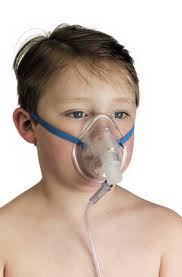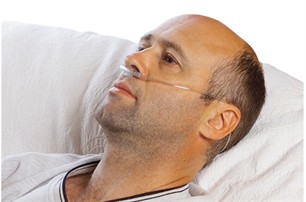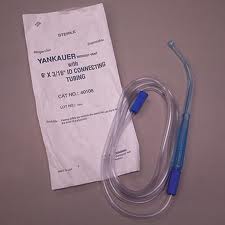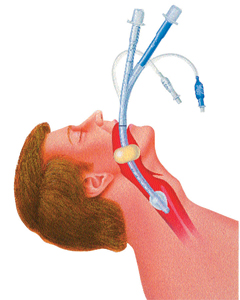Oxygen therapy
Oxygen therapy is a treatment that provides extra oxygen to the tissues of the body through the lungs and is provided to a casualty as a supplement to normal respiration. Certain injuries and conditions lead to a loss of ability to maintain oxygen to the body at the required level. Oxygen therapy provides a regulated flow of supplementary oxygen to 'build up' to the necessary level. Oxygen therapy is usually delivered by a face mask, but nasal prongs can also be used.
 Face masks
Face masks
These are adult or child sized plastic disposable items that fit over the casualty's nose, mouth and chin. They are attached to the regulating device outlet by clear plastic tubing Oxygen delivered via a face mask mixes with air drawn in through holes in the body of the mask. Expired air is exhausted through the holes when the casualty exhales. The percentage of oxygen administered depends on the flow rate from the outlet.
The main disadvantages are the casualty may feel claustrophobic and speech is distorted through the mask
Nasal prongs
These are plastic prongs set within a length of clear plastic tubing and are designed to fit into the casualty's nostrils. The disadvantage is a blocked nose; sinusitis or a cold sometimes negates the benefits and delivers only low concentrations of oxygen.
100% oxygen
100% oxygen is administered to casualties in respiratory arrest or whose unsupported breathing is insufficient to maintain consciousness.

Demand valve devices
100% oxygen is delivered from the regulating device directly to a demand valve. A firmly fitting, sealed mask is attached to the demand valve. When the casualty breathes, the demand valve is triggered and a measured amount of 100% oxygen is delivered.
Manually triggered devices
On some mechanical devices, the demand valve can be triggered by an operator and oxygen can be administered to a non-breathing casualty.
Soft bag and mask devices
These devices consist of a soft bag and reservoir attached to a mask. 100% oxygen is
- Delivered into the bag via the reservoir and the bag is compressed to administer oxygen
- To the casualty through the mask. The disadvantage of these devices is the care
- Required to continually assess the casualty. It is easy to inflate the casualty's stomach or
- Worsen chest and lung injuries or conditions
Suction
 Suctioning uses a manual or powered vacuum device to remove foreign materials or fluids from the casualty's airway.
Suctioning uses a manual or powered vacuum device to remove foreign materials or fluids from the casualty's airway.
Problems often occur, secondary to prolonged suctioning where secretions and inspired oxygen are removed and could result in the low oxygenation and damage to the soft membranes of the mouth.
Suction catheters come in two main types:
Yankauer sucker
 A one-size rigid plastic tube useful in removing large quantities of matter or fluids - Caution should be used with this piece of equipment to avoid damage to the patient's mouth area.
A one-size rigid plastic tube useful in removing large quantities of matter or fluids - Caution should be used with this piece of equipment to avoid damage to the patient's mouth area.
Y-suction catheter
Flexible plastic tubing of various sizes - It is unable to remove large quantities of matter or fluids and it is easily blocked. The advantage is that it is soft and flexible.
Care in the use of oxygen
Although oxygen is beneficial, care is essential in administering it. Due to the skill required to use the above devices, they should be restricted to those providers who are trained and qualified and used in accordance with the level of training.
Oxygen for medical use
Medical oxygen is stored under pressure (up to 13,400 kPa) in steel or aluminium cylinders and can be identified using the following features.
- Australian standard pin index valve for oxygen equipment
- Ensure the cylinder is white
- The cylinders should be labelled 'Medical Oxygen' Common cylinder sizes are:
- 'B' - 200 litres when full
- 'C' - 400-490 litres when full
- 'D' - 1500 litres when full
- 'G' - 7600 litres when full
Oxygen cylinders from different companies often hold slightly different quantities of gas.
The most common sizes for mechanical resuscitators are the 'B' and 'C' and fixed oxygen equipment normally use 'D' size cylinders or larger.
Preparing a cylinder for use
A full cylinder should have a plastic stopper inserted in the valve outlet, or if a smaller cylinder, plastic tape wound around the outlet.
- When preparing a cylinder for use:
- Check the external condition and colour of the cylinder
- Check the valve and outlet port and wipe them clean
- Remove the plastic stopper or tape and check for moisture in the outlet port
- Point the cylinder away from you and 'crack' the valve for one second
- Ensure the valve is turned off tightly
Oxygen delivery
The gas is delivered through a valve to a regulating device which reduces the pressure to a safe 390-400 kPa. The oxygen flow is then delivered through a 'yoke' device that fits onto the valve stem of the cylinder. The yoke has fittings that match the valve stem and has a measuring device attached to control the flow of oxygen.
Flow rates of oxygen are varied by either a fixed flow outlet set between 3-8 litres per minute (lpm) or by an adjustable flow meter that delivers between 1-25 lpm. This is consistent with the requirements for supplementary oxygen therapy. Full flow rates of oxygen are supplied directly to a demand valve in the case of a mechanical resuscitator.
When delivering oxygen via a therapy mask you can expect 30 minutes at 15 lpm from a full 'C' cylinder (440 Litres).
Connecting oxygen equipment
When the selected cylinder has been prepared, connect the equipment as follows:
- Attach the appropriate yoke device, ensuring that the valve fittings correspond to those on the valve stem
- Tighten the locking screw gently with a cylinder spanner (larger cylinders) or 'finger tight' (smaller cylinders)
- Attach appropriate oxygen therapy or mechanical resuscitator devices
Cylinder storage
Store oxygen cylinders carefully in accordance with relevant government regulations. Prior to storing cylinders, you should contact your company or organisation's OH&S representative for direction and advice.
Some important points are:
- Cylinders should be kept cool, dry and undercover
- All cylinders should be kept in a secure but accessible area near the oxygen equipment
- Cylinders should be contained or secured to prevent movement and precautions should be taken to prevent them falling over
- The storage area should be out of direct sunlight and away from heat
- Full and empty cylinders should be clearly marked and kept stored separately
- The storage area should have the regulation signage
- There should be no naked flames or smoking allowed within 25 metres of stored oxygen cylinders
- Empty cylinders should be returned for filling without delay
Do not store near grease or oil